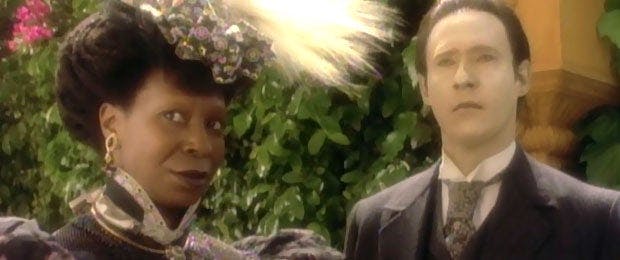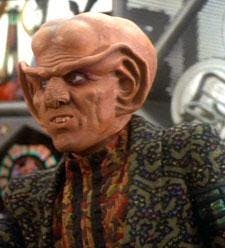Published Jun 4, 2014
Meet Emmy Award-winning Robert Blackman, Part 2
Meet Emmy Award-winning Robert Blackman, Part 2

As much as anyone involved in the modern era of Star Trek, Robert Blackman had a profound effect on what fans saw on The Next Generation (seasons 3-7), Deep Space Nine, Voyagerand Enterprise, as well as Generations and First Contact. Blackman’s gig as Star Trek’s costume designer spanned nearly two decades and earned him two Emmy Awards; he was nominated 10 times in total for Star Trek. Since the end of Enterprise, he has worked on Pushing Daisies (for which he won another Emmy), The Cape, Rizzoli & Isles, GCB and, most recently/currently, Glee. Blackman has been way up there on StarTrek.com’s “must-interview” list for several years now, and we’re pleased to say that he has at long last granted us an interview.

The occasion? Blackman will appear as a guest at the upcoming Creation Entertainment Official Star Trek Convention in Las Vegas, set to be held July 31 to August 3. He’s on board to do a Q&A from the stage and will also participate in the planned Cosplay Saturday, part of which will involve him serving as a judge during the Star Trek Las Vegas Costume Competition. Below is part two of our extensive, three-part conversation with Blackman, and it kicks off our ongoing series of interviews with guests who’ll be appearing at Creation Entertainment’s Official Star Trek Convention in Las Vegas. Keep an eye on StarTrek.com for a new interview each week, building to the event itself.

We’ll go show by show, but let’s talk about some of the design opportunities you had on The Next Generation. You had the Sherlock Holmes episodes, Robin Hood…
BLACKMAN: Those were all in my ballpark, so I loved that. I loved the Robin Hood stuff. I loved “Time’s Arrow,” the Victorian ones. I had to just replicate the 1940’s looks, because they’d already been established the previous season. The Sherlock Holmes episodes I did with Brent, I played around with the designs a little bit and made them my own. At some point, as they were expanding the look of the show, I had to come up with an alternative version of the Klingon uniform, which Robert Fletcher had designed for the movies. Those designs had lasted all the way through and they were built so brilliantly. So I had to come up with some other way to manufacture them so that we could do ranks, at least on the officers, but so that when we needed 15 guys, we could use the costumes for them, too. So I devised a way of using fake leather, essentially, and vinyl car trim, to make it look like those Klingon things. They were pretty close matches. We had all buckles made the same. We had all the hardware done as it was. So, in a crowd, I don’t think a lot of people would have noticed the difference. I’m really proud of that because it allowed us to do an enormous amount of things with the Klingons.

BLACKMAN: Majel was great. She and I had a great time together. I really loved her. I’ve got one story after another that I can’t really tell you, but they were hilarious. She was a classy broad, a classy dame. Once we did the first round of things and she saw them, she just committed and said, “Let’s do it.” There wasn’t a lot of discussion in the fittings about how she’d look. She really trusted me and we just had a lot of fun.
A lot of the major costume changes came in the wake of First Contact, with the changes carrying over to Deep Space Nine and Voyager, etc. Take us through that window of time.
BLACKMAN:First Contact was a very interesting experience because we essentially designed a uniform that, at the end of the day, didn’t work. And they were ex-ed out. So we kept The Next Generation uniforms and used those. Then, after that, when they went on to Deep Space Nine, we switched the colors out, to make it more serious, to make it darker. So that’s where I came up with the quilted shoulder panels and the dark jackets, and then having the division color just as a turtleneck. That came out of wanting to have a new look for the new series. And quite frankly, some of that was driven by the fact that they were looking for ways to keep their ancillary income coming in. They needed a new look so that they could make more toys, make more toys, make more of that stuff. So that’s one of the reasons why there was a uniform change with every series. That was one of the reasons. There were character reasons as well, but there was the notion that we needed to have a new look.

There were so many other fascinating costumes and looks on DS9. The Cardassians were first seen on TNG, but they were quite prominent on DS9…
BLACKMAN: They started on TNG, but evolved on Deep Space. The Cardassians on TNG were one of the most complicated things I ever did on that show. They had like 209 pieces of structure underneath the stretched leather, to make all that angular stuff, to give them that insect look. That wasn’t going to work on Deep Space. Nobody could afford to do 30 of those from the get-go. And they were going to be involved in a lot of the action. I know that upfront, so I proposed this look that you saw, which, pretty much from sketch to realization, stayed the same. All those costumes were blown rubber jackets, essentially. They were colored to the right color, and then there was a piece of Spandex laid on the back of it while the rubber was still wet. Then they were brought out and trimmed. They were made to be adjustable. So they had pop-in side panels and pop-in shoulder panels that would allow you to either lengthen them or shorten them. And then they went over green Spandex jumpsuits. Then there were big boots.
The thing about Star Trek I loved so much was this… Rick Berman and I were talking at one point. I was doing something and we looked at it in rushes and he said, “Well, that is terrible.” I said, “Well, look, for me to keep growing on this thing, I need to experiment. So there’s going to be 10 or 15% of the episodes that have something in that’s a flop because I’m experimenting with new techniques, new products, new whatever. I will make it all look finished and done, but we may decide it went too far or that was too heavy-looking or too long.” But he allowed me that. He agreed that I could experiment. And he certainly provided me with a staff to be able to do that. The Cardassians on Deep Space were some of my first big rubber outfits.

Another major alien you did on DS9, that originated on TNG, was the Ferengi…
BLACKMAN: They were just crazy. And I had these actors who would never say no. Armin Shimerman would never say no. We would put more stuff on him, more things together, to make his outfits. And we just loved it. The Ferengi were our favorite things to do, really, because they were so theatrical and big and colorful, and the episodes were always fun. We also had a lot of Bajoran uniforms, but they fit into the same mode that all the uniforms we’ve been talking about fall into.
Let’s move on to Voyager. You were there from the start. What was your mission, costume-wise, on that show?
BLACKMAN: Rick wanted something that was a little bit more hands-on. So, for Voyager, we started with these very utilitarian uniforms, like NASA, but still within the Star Trek universe, as we had set it up. That means that there were no zippers, no visible closures. It all looks like it was all mysteriously put on them in the morning. Nobody knows how anybody gets into the clothes, theoretically. That was from Next Generation into Deep Space Nine and even into Voyager, but we added pockets and some small things to it. The costumes on Voyager, they were much more rough-and-tumble.
And then along comes Jeri Ryan to play Seven of Nine…
BLACKMAN: They realized that they didn’t have a female that was attracting the 18-34 year-old males, and so that’s why Seven of Nine came on. So they brought in this beautiful, wonderful woman. I couldn’t say enough nice things about Jeri. I was doing sketches for Rick. And Rick said, “Don’t you think we should have it plunging or something like that…?” I said, “If I can get this to look like it’s been sprayed on her, it’ll be sexy.” The original one went over her shoes and the only things you saw, really, were her hands and her face. It was a remarkable feat of engineering that Esther, the cutter-fitter, and I did. It took us a while to evolve it. What I loved about the original one was that the fabric allowed the corset that was worn underneath it to show all of those regeneration tubes. Then, as we changed it and tried to give it more variety, the fabrics that were available didn’t accentuate that enough, didn’t show that as much. But that silver version was outstanding.
They were having problems with the fact that Seven of Nine looked too sexual. That’s why that uniform got changed to the darker colors with the lower necklines and all of that. Part of it was also how it was how it was photographed and how it was lit. Those guys were probably given all the same directives that I was given, but I think that suit would have worked with different lighting and just not always focusing or making her bustline the major part of her frontage. Because I thought silver costume was the one that really set Seven apart. She attempts to become more human, so it needed to go away, of course. I get that, but I wish it had last a little longer than it did.
Click HERE to read part one of our interview with Robert Blackman and visit StarTrek.com again tomorrow to read part three.And visit creationent.com to purchase tickets to the Official Star Trek Convention in Las Vegas.

